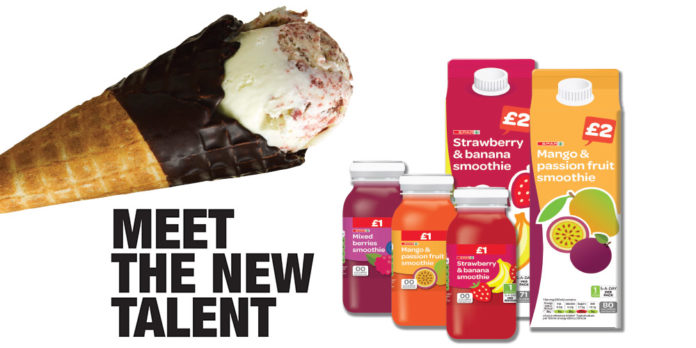No longer just a way for consumers to save money, own-label brands are now branching out into premium products. Helena Drakakis discovers the new stars of the shopping basket – and why they’ve fans in foodservice, too.
There was a time when own-brand labels were reserved for the economy shopper. Today, consumers’ preference for quality goods at low prices has fuelled demand, making own-labels the stars in any shopping basket.
Undercut by the rise of discounters Aldi and Lidl, the UK’s favourite brands saw a significant drop in popularity last year. According to market analyst Kantar Worldpanel, sales of branded FMCG items experienced an overall decline of 1.6%, yet own-label ranges saw an increase of 1.7%.
In foodservice, too, own-label continues to shine brightly. The rise of affordable dining means many wholesalers have either launched own-label ranges or have added to an existing catalogue.
Everyday great value
Own-label is not new – its presence in shoppers’ lives goes back several decades – but the market it attracts is new. Consumers trust own-label products in a way not seen previously, with more choice available. In turn, own-label is stealing a march on on-trend products normally reserved for trusted names.
“It’s essential that wholesalers see own-label as a point of difference and a way to increase customer loyalty,” says Jon Burton, senior trading controller at Landmark Wholesale, the buying group behind the 800 product-strong Lifestyle and Lifestyle Value ranges.
According to Spar UK’s head of brand Cath McIlwham, the company’s own-label range is going from strength to strength, with a turnover of more than £300m in retail sales.
Alongside popular own-label ready meals, ‘meal for tonight’ component cooking is also on the rise. Costcutter, which operates the Independent own-label, launched the ‘Tasty in no Time’ campaign this year to showcase products from carrots and potatoes to a selection of cheese.
Jodene Rogers, Costcutter’s head of marketing, says: “Today’s shoppers are extremely time-poor and they are always looking for high-quality meal solutions. The ‘Tasty in no Time’ campaign provides shoppers with some great suggestions for fantastic fuss-free meals in minutes.”
Fresh and premium choice
Research by Kantar Worldpanel this year showed that consumers are buying premium own-label products, even those more expensive than branded goods. This trend is evident in supermarkets, with Morrisons’ premium own-label range The Best the key to the retailer’s success during the first half of this year. Waitrose also launched a premium range last year, Waitrose 1, and Aldi and Lidl have invested heavily in their ‘best’ category.
In the convenience channel, premium is still limited, but everything points towards there being room for growth in an unsaturated market, thanks to a growing emphasis on provenance and health. Booker’s Farm Fresh range was extended to Budgens and Londis convenience stores last year, following their acquisition by the wholesaler in 2015.
Bestway announced this year that it was overhauling its own-label range and introducing a premium range called Best-One Inspired. The range initially comprises 15 lines, including all-butter cookies, strawberry and cherry conserves, and pesto.
Meanwhile, the focus for Nisa this year is to expand its Heritage brand, with a focus on fresh produce.
Own-label foodservice
What about foodservice? With increased costs and consumers expecting more for their money, own-label helps caterers to deliver quality food at a cheaper price. A good quality range means chefs don’t compromise their offer yet protect their margins. Own-label also makes it relatively easy to keep on top of the changes in allergen and nutritional food labelling regulations.
Country Range Group refreshed its own-label range back in 2015 when the Food Information Regulations 2013 came into effect, making the nutritional information clear. Other own-label brands, too, have revised their offer to cater better to restaurants, pubs, cafés and other casual dining outlets.
This year, buying group Caterforce relaunched its range, Chefs’ Selections, expanding its portfolio as well as refreshing the brand, which makes up £35m of its £500m turnover. Caterforce managing director Nick Redford says: “A great deal of work has been put into further developing the Chefs’ Selections brand. We’ve drawn heavily on the passion for food in our business.”
In a similar vein, Bidfood recently relaunched its own-brand portfolio of four ranges: Essential Supplies, Everyday Favourites, Premium Selection, and Farmstead. Holly Marrero Easson, Bidfood’s own-brand manager, says: “We’ve created a new non-food brand and a new premium brand, allowing customers to find what they are looking for more quickly and simply.”
Foodservice wholesalers are also leading the way in helping caterers respond to trends. For example, JJ Food Service launched its own-label Super Crisp Chips range to help pubs and restaurants offer gluten-free foods.
Meanwhile, Fairway Foodservice has tapped into the trend in world foods with its new addition of tempura-battered chicken, alongside unusual desserts such as courgette and avocado cake.
Whether you serve retail or foodservice customers (or both), own-label is a category not to be dismissed.
Retailer Viewpoints
 “I’m a Family Shopper, and our Euro Shopper non-branded goods sell really well. Water sells really well at this time of year and in that category, the Euro Shopper non-branded sells far better than branded – it’s 39p for a 500ml bottle, so people are naturally attracted to that.”
“I’m a Family Shopper, and our Euro Shopper non-branded goods sell really well. Water sells really well at this time of year and in that category, the Euro Shopper non-branded sells far better than branded – it’s 39p for a 500ml bottle, so people are naturally attracted to that.”
Sunita Kanji, Family Shopper, Little Hulton, Greater Manchester
 “I keep a mix of own-label and branded products. I get better margins on branded, as I operate in an affluent area. Tinned products and household goods like toilet rolls and dog and cat food sell well on own-label, but pricemarked, branded products seem to be more popular.”
“I keep a mix of own-label and branded products. I get better margins on branded, as I operate in an affluent area. Tinned products and household goods like toilet rolls and dog and cat food sell well on own-label, but pricemarked, branded products seem to be more popular.”
Surekha Patel, Best-One, Bexhill-on-Sea, East Sussex
 “I use own-label for consistency and cost. You get the same quality and it usually adds 10% margin on whatever I am buying. For example, I use own-label mushy peas from the Q Brand, Friars Pride. The branded equivalent is more pleasing to the eye, but there’s no real difference in taste, and they are not what customers expect from mushy peas.”
“I use own-label for consistency and cost. You get the same quality and it usually adds 10% margin on whatever I am buying. For example, I use own-label mushy peas from the Q Brand, Friars Pride. The branded equivalent is more pleasing to the eye, but there’s no real difference in taste, and they are not what customers expect from mushy peas.”
Stuart Fawcett, Flipping and Frying, Lincolnshire
 “We’re a restaurant next to a spa and gym, and we try to alter our menu every month. We use Brakes and Booker, and within our order, there’s a lot of own-label non-food kitchen items as well as food items. This helps us keep costs down and create an affordable but quality menu.”
“We’re a restaurant next to a spa and gym, and we try to alter our menu every month. We use Brakes and Booker, and within our order, there’s a lot of own-label non-food kitchen items as well as food items. This helps us keep costs down and create an affordable but quality menu.”
Stephen Mitchell, The Orchard, Bedfordshire








